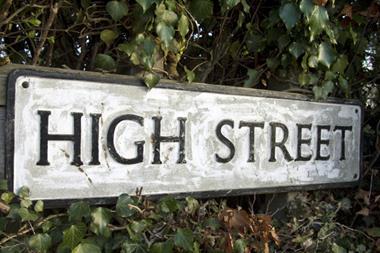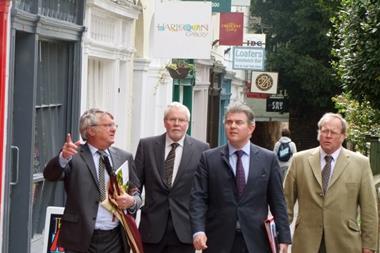Despite better news on vacancy rates of late, figures from the Local Data Company suggest a staggering 6,500 high-street shops have gone to the wall since a cross-party group of MPs first started discussing what to do to tackle Britain’s high-street crisis a year ago, almost to the day.
When they finally did conclude their inquiry this week, the BIS select committee identified by far the biggest cause of business failures as the outdated and unfair system of business rates, which it describes as the “single-biggest threat to high-street retail firms.” The report, which accuses the government of paying lipservice to the issue while tinkering around the edges with “good intentioned” but flawed strategies such as the Portas Pilots (see p6), is far from a lone voice.
From the 2011 Portas Review itself to the BRC’s February report The Road to Reform, retail groups and prominent individuals in the industry, including former Iceland boss Bill Grimsey and, most recently, former Tesco chief Sir Terry Leahy, have all been calling for urgent rates reform, or for rates to be scrapped altogether.
But while there is overwhelming consensus on what the problem is, the opposite is true when it comes to potential solutions. And with different sectors now starting to squabble over the unfairness of possible alternatives, will retailers be stuck with the devil they know?
The BIS inquiry exposes one of the biggest likely battlegrounds. The MPs want a review that “must include whether taxes should be based on sales rather than property,” which suggests that not only should the biggest companies on the high street pay more, but also online companies should share the load, an issue that has become a massive hot potato since the inquiry first started. Crucially, in the case of supermarkets and other major retailers, that would be a double whammy.
The report also recommends the government explore adopting a US-style tax structure, which - ironically - Sainsbury’s actually floated in its evidence as a way to “level the playing field” between bricks and clicks.
US fairness tax
Tim Fallowfield, corporate services director at Sainsbury’s, told the inquiry: “In the US, they have introduced a main-street fairness tax, which is redistributing the tax burden by applying effectively a local sales tax, which would obviously apply equally to online retailers and bricks and mortar retail. We would suggest that would be a very worthwhile review by government - to try to make sure there is a level playing field.”
Yet by the time Sainsbury’s CFO John Rogers spearheaded the launch of the BRC’s February report The Road to Reform, there was not a single reference to “levelling the playing” field at all, let alone any mention of a “fairness tax”.
Instead the BRC, which hailed the MPs’ report this week as the “final nail in the coffin for business rates,” is exploring alternatives, which have proved nothing if not divisive. Its Road to Reform report lists three alternative models, the most radical of which suggests, instead of a sales-based tax, shifting the basis of taxation from property to “energy use”.
It has also floated a new system based on tax incentives for companies that employ the most people, and a third option rewarding successful businesses with incentives based on how much corporation tax they pay. BRC director general Helen Dickinson claims the proposals are about “positive incentives” rather than the “negative disincentives” inherent in rates, but some see the moves as a bid by the supermarket chains to skew a new system in their favour. “We’ve been having wide, open conversations with retailers of all sizes,” she says.
But the controversy surrounding the BRC’s plans illustrates just how difficult it will be for government to come up with a new taxation system that would satisfy all parties in the debate. One senior retail figure even told The Grocer the BRC had dodged the easiest and most fair measure - increasing VAT by 2.5% - because “BRC chairman Ian Cheshire’s Kingfisher business would be hit so much harder than the supermarkets due to its low sales densities, and the fact food is non-VATable.”
More importantly, convincing the Treasury it is worth jettisoning a system generating a guaranteed £25bn a year - £7bn of that from retailers - in favour of one that is completely untried, looks almost imp0ssible.
High streets minister Brandon Lewis told The Grocer in December that nobody had yet come up with a system as effective as rates, despite its flaws, and says a Treasury review (see box) will concentrate on the administration of the tax, rather than a replacement.
BIS committee chair Adrian Bailey believes this week’s report is likely to result in some sort of overhaul of the existing system - the one option the BRC insists it does not want. Among its recommendations are a six-month business rates amnesty for businesses occupying empty properties, which would go further than the 50% reduction announced by the Chancellor in the Autumn Statement as part of a £1bn government rescue package, lauded by Lewis but condemned by the MPs’ report as half-hearted.
Rates: what next?
BRC review: E&Y due to present further findings in next stage of BRC’s Road to Reform report in May. Its three proposed models include replacing rates with an energy tax, tax incentives based on corporation tax contributions, or a third system based on number of employees.
Treasury review: Autumn Statement promised “reform of business rates on the agenda for 2017 revaluation”. But the government has since stressed this is “administrative reform”.The review is looking at “strengthening its responsiveness to changes in property values and its simplicity and transparency to business ratepayers”.
Delayed revaluation: In October 2012, the government announced a delay to its anticipated 2015 revaluation - based on rental values in 2013 - until 2017. It claimed pressing ahead would have led to 800,000 losers, as opposed to 300,000 winners, with the losers including pubs, petrol stations, and independents, and the real winners (Bill Grimsey also claimed) the supermarkets - to the tune of £1.3bn over two years.
The report also calls for the government to consider using CPI (not RPI) as the basis for rates (a Portas proposal) and to introduce an annual system of revaluations - compared with the existing system, which, until 2017, will see businesses judged on 2008 property values.
But whether the government sees business rates as a vote-winner worth upsetting the apple cart for seems unlikely, especially with such uncertainty over what could replace them. “Business rates have been the elephant in the room throughout our retail inquiry,” says Bailey, “But do I think the government has the appetite to make the fundamental changes? On the basis of the feeble response so far, I would have to say no. The brutal reality is they are not going to suddenly change tack.”



















No comments yet